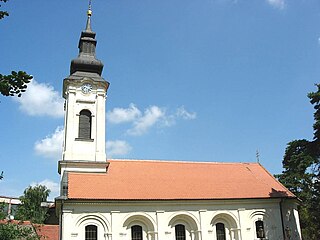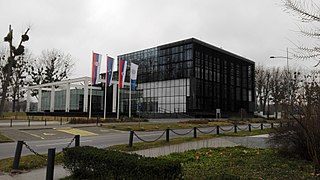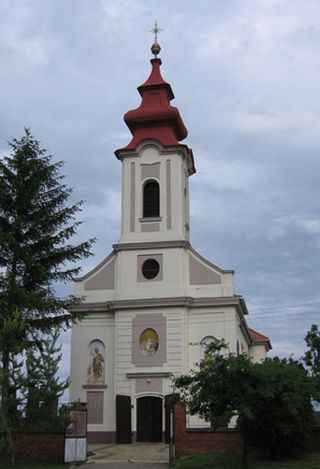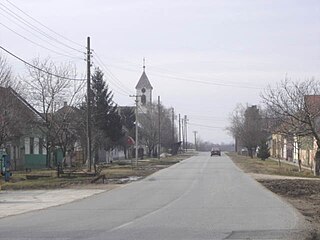
Novi Sad is the second largest city in Serbia after the capital Belgrade and the capital of the autonomous province of Vojvodina. It is located in the southern portion of the Pannonian Plain on the border of the Bačka and Syrmia geographical regions. Lying on the banks of the Danube river, the city faces the northern slopes of Fruška Gora and it is the fifth largest of all cities on the Danube river. It is the largest Danube city that is not the capital of an independent state.

Vojvodina, officially the Autonomous Province of Vojvodina, is an autonomous province that occupies the northernmost part of Serbia, located in Central Europe. It lies within the Pannonian Basin, bordered to the south by the national capital Belgrade and the Sava and Danube Rivers. The administrative centre, Novi Sad, is the second-largest city in Serbia.
Futog is a village of the city of Novi Sad, Serbia, with a population of 18,642 according to the 2011 census in Serbia. It is situated in southern Bačka, 7 km away from Novi Sad.

Novi Kneževac is a town and municipality located in the North Banat District of the autonomous province of Vojvodina, Serbia. The town has a population of 5,688, while the Novi Kneževac municipality has 8,627 inhabitants according to 2022 census.

Temerin is a town and municipality located in the South Bačka District of the autonomous province of Vojvodina in Serbia. The town has a population of 17,998, while the municipality has a population of 25,780.

Žabalj is a town and municipality located in the South Bačka District of the autonomous province of Vojvodina, Serbia. According to 2022 census, the town Žabalj has a population of 8,449 and the municipality Žabalj has a population of 23,853. It is located in southeastern part of Bačka, known as Šajkaška. All settlements in the municipality have an ethnic Serb majority.

The Serbs of Vojvodina are the largest ethnic group in this northern province of Serbia. For centuries, Vojvodina was ruled by several European powers, but Vojvodina Serbs never assimilated into cultures of those countries. Thus, they have consistently been a recognized indigenous ethnic minority with its own culture, language and religion. According to the 2022 census, there were 1,190,785 Serbs in Vojvodina or 68.43% of the population of the province.

The University of Novi Sad is a public university in Novi Sad, Serbia. Alongside nationally prestigious University of Belgrade, University of Novi Sad is one of the most important educational and research institutions in Serbia and South Eastern Europe and the flagship institution of higher education in Vojvodina. The University of Novi Sad, with almost 50,000 students and more than 5,000 employees, is one of the largest educational and research centers in Central Europe. It belongs to the group of comprehensive universities, which are characterized by providing nearly all fields of science and higher education. It is composed of 14 faculties and three scientific institutes located in four university cities - Novi Sad, Sombor, Subotica and Zrenjanin. Institution belongs to the group of comprehensive research universities with significant level of research activities.

Čenej is a suburban settlement of the city of Novi Sad, Serbia.

Srpski Krstur is a village located in Serbia, in the Novi Kneževac municipality of the North Banat District, in the Autonomous Province of Vojvodina. The village has a Serb ethnic majority (69.81%) with a present Romani (13.58%) and Hungarian minority (9.38%). It has a population of 1,620 people.

Hungarians in Serbia are a recognized national minority in Serbia. According to the 2022 census, the population of ethnic Hungarians in Serbia is 184,442, constituting 2.8% of the total population, which makes them the second-largest ethnic group in the country behind Serbs and the largest minority group. The vast majority of them live in the northern autonomous province of Vojvodina, where they number 182,321 and make up 10.5% of the province's population. Almost 99% of all Hungarians in Serbia live in the province of Vojvodina. Most Hungarians in Serbia are Roman Catholics, while smaller numbers of them are Protestant. Their cultural center is located in Subotica.

Bačko Gradište is a village located in the Bečej municipality, in the South Bačka District of Serbia. It is situated in the Autonomous Province of Vojvodina. The village is ethnically mixed and its population numbering 5,445 people. Largest ethnic groups in the village are Hungarians (46.26%) and Serbs (44.39%). Linguistically the village has a Slavophonic plurality as Serbs, Yugoslavs, Croats, Montenegrins and ethnic Muslims collectively compose 49.35% of the population. In early 2007, the village was, among others, affected by the measles outbreak that attracted WHO attention.

Vilovo is a village located in the Titel municipality, South Bačka District, Vojvodina, Serbia. As of the 2011 census, it has a population of 1,090 inhabitants. In the 1990s, after the collapse of Yugoslavia, the town saw a large influx of Bosnian immigrants, which led to the nickname Panićovo, due to the high number of residents with the surname Panić.

Maradik is a village in Serbia. It is situated in the Autonomous Province of Vojvodina, in the region of Syrmia, in Inđija municipality. Maradik is located about 10 km west of Inđija. The village has a 60% Serb ethnic majority and its total population in 2011 was 2,095.

Gospođinci is a village in the municipality of Žabalj, in the South Bačka District of Serbia. It is situated in the Autonomous Province of Vojvodina. The village has a Serb ethnic majority and its population is 3,896.

Veliki Radinci is a village in Serbia. It is situated in the Sremska Mitrovica municipality, in the Syrmia District, Vojvodina province. The village has a Serb ethnic majority and its population numbering 1,426 people.

Gakovo is a village in Serbia. It is situated in the Sombor municipality, in the West Bačka District, Vojvodina province. The village has a Serb ethnic majority and its population is 2,201.

Čortanovci is a village located in the Inđija municipality, Srem District, Vojvodina province, Serbia. It As of 2011 census results, the village has a population of 2,337 inhabitants.

Banatski Despotovac is a village in Serbia. It is located in the municipal area of the City of Zrenjanin, in the Central Banat District, Vojvodina province. The village has a Serb ethnic majority (98.2%) and its population numbers 1,620 people.
Majdan is a village in Serbia. It is situated in the Novi Kneževac municipality, in the North Banat District, Vojvodina province. The village has a Hungarian ethnic majority (85.95%) and its population numbering 292 people.





















